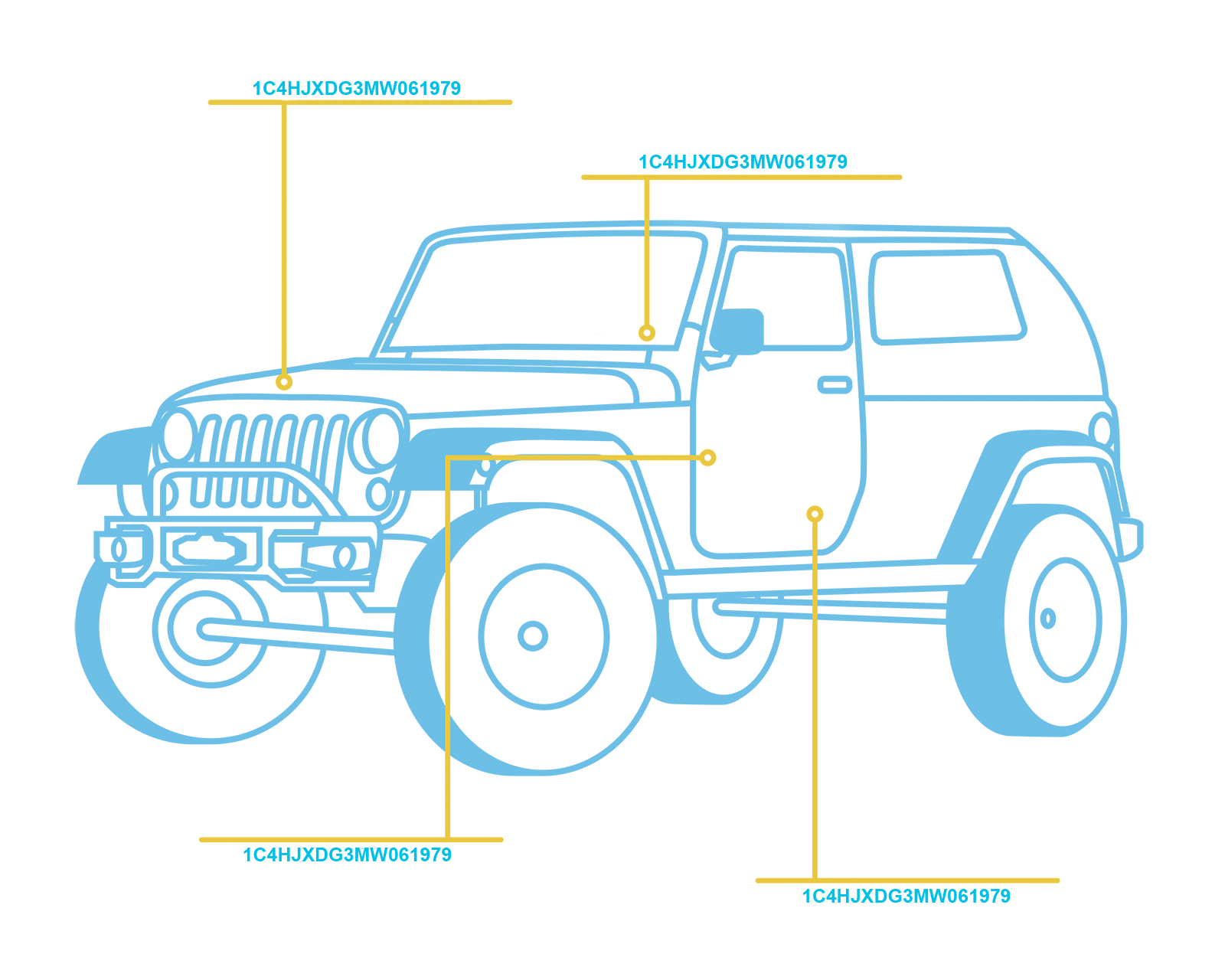Enter the 17-digit (VIN) vehicle identification number in the box above and you will instantly receive all information about the manufacturer, make, model and series, body type, engine size, year of manufacture and vehicle serial number.
All information provided by the National Highway Traffic Safety Administration (NHTSA) based on data provided by manufacturers to the NHTSA.
Our VIN decoder is only intended for use with vehicles manufactured from 1981 onwards.
If your car was manufactured before 1981, the VIN number will be 11 characters long and our VIN decoder will not be able to decode it, so only use the 17-digit VIN number.
VIN is a unique vehicle code, which consists of 17 letters and numbers without spaces, while the letters I, O and Q are not used in the VIN number due to the similarity with the numbers 1 and 0, VIN numbers are most often printed in one line.
The VIN number contains information about the country of the manufacturer, make, model, year of manufacture, serial nomenclature of the vehicle.
The VIN format is based on ISO 3779 (adopted in the USA and Canada in 1977) and ISO 3779: 1983 (last revised from 1996).
Identification numbers are applied or embossed on one-piece body or chassis components and on specially made number plates.

The VIN number is located under the bonnet at the front of the cylinder block on most vehicles, and on the bulkhead between the bonnet and the passenger compartment.
The VIN number is also located on the windshield and is most often located on the driver's side under the lower part of the windshield from the outside of the vehicle.
The VIN number most often in older cars can be indicated in the front of the frame on the driver's side on the door sill.
The VIN number is most often indicated in new cars on the inner pillar on the side of the driver's door.
VIN-number contains 17 characters in which data about the vehicle are encrypted: make, model, version, year of manufacture, engine and transmission, body type and much more.
The VIN number that was assigned to the vehicle in production cannot be changed for the entire period of operation.
Also, the original VIN number should not contain: different character depths, differences in the font, unnecessary elements or strokes, welds, traces of mechanical stress, putty, changed thickness of the panel or outer coating, the difference between the display of the code from the outside and the back, differences between the coverage of the panel and the surrounding areas.
In the figure below you will find out what information the symbols of the VIN number contain.

The VIN number of the vehicle consists of three parts.
WMI (World Manufacturers Identification) - the world manufacturer's index (from the 1st to the 3rd characters of the VIN number).
VDS (Vehicle Description Section) - a descriptive part (from the 4th to the 9th characters of the VIN number).
VIS (Vehicle Identification Section) - a distinctive part (from the 10th to the 17th characters of the VIN number).
WMI (World Manufacturers Identification) - international manufacturer identification code, consists of three characters (letters or numbers).
Several WMIs can be assigned to a manufacturer, but the same number must not be assigned to another manufacturer for at least 30 years from the moment it was first used by the previous (first) manufacturer.
If the manufacturer produces less than 500 vehicles per year, then the third character of the code will be the number 9.
The first character in WMI is a letter or number that represents a geographic area code. Several symbols are assigned to each of the zones.
The second character in WMI is a letter or number that represents the country. The country is determined by the combination of the first and second character of the code.
The third WMI character is a letter or number assigned to the manufacturer by the national organization. Sometimes it can mean the type of vehicle or the production department.
VDS (Vehicle Description Section) - consists of six characters (letters or numbers) that define the type and characteristics of the vehicle.
The 4th, 5th, 6th, 7th, 8th VDS characters describe the characteristics of the vehicle, such as: model line, body type, engine type, steering wheel position, power system and transmission type, drive and etc.
The 9th character of VDS, for manufacturers from the USA and China, is a security check digit, it is one of the means of protection against interrupting a VIN number. European and Asian companies do not always follow this standard and use this symbol for additional information about the vehicle.
VIS (Vehicle Identification Section) is an indicative part consisting of eight characters (letters or numbers) and contains: year of manufacture, assembly plant, serial number of the vehicle. In this case, the last four characters must be numbers.

|
Category:Body Shops Address:4827 N 90th St Omaha, NE 68134 Location on the map:Show! Tags:Body Shops, Windshield Installation & Repair, Towing |

|
Category:Car Wash Address:11795 W Colfax Ave Lakewood, CO 80215 Location on the map:Show! Tags:Car Wash |

|
Category:Parking Address:14 Kenmare St New York, NY 10012 Location on the map:Show! Tags:Parking |

|
Category:Car Wash Address:1050 W Beta St Green Valley, AZ 85614 Location on the map:Show! Tags:Car Wash |

|
Category:Car Wash Address:4640 S 27th St Milwaukee, WI 53221 Location on the map:Show! Tags:Body Shops, Auto Repair, Car Dealers |

|
Category:Car Wash Address:Not specified Location on the map:Show! Tags:Handyman, Auto Detailing, Landscaping |

|
Category:Towing Address:Not specified Location on the map:Show! Tags:Towing, Tires, Roadside Assistance |

|
Category:Body Shops Address:1340 Hwy 51 bypass S Dyersburg, TN 38024 Location on the map:Show! Tags:Towing, Body Shops |

|
Category:Car Dealers Address:4605 Houston Levee Rd Collierville, TN 38017 Location on the map:Show! Tags:Car Dealers, Auto Repair |

|
Category:Towing Address:9966 Rochester Rd Middleport, NY 14105 Location on the map:Show! Tags:Towing, Roadside Assistance |

|
Category:Towing Address:6635 S Tenaya Way Ste 210 Las Vegas, NV 89113 Location on the map:Show! Tags:Auto Repair, Oil Change Stations, Towing |

|
Category:Car Dealers Address:13501 N US 183 Ste C Austin, TX 78750 Location on the map:Show! Tags:Auto Repair |

|
Buy Now:USD 1,200 Year:2010 Mileage:387,715 mi Transmission:Automatic Loss Type:Other Other:Key Available Stock Number:42693115 Location:Charlotte, North Carolina |

|
Buy Now:USD 700 Year:2008 Mileage:273,237 mi Transmission:Automatic Loss Type:Other Other:Key Available Stock Number:42694208 Location:Elkton, Maryland |

|
Buy Now:USD 2,050 Year:2016 Mileage:148,020 mi Transmission:Automatic Loss Type:Other Other:Key Available Stock Number:42694231 Location:Northern Virginia, Virginia |

|
Buy Now:USD 500 Year:2013 Mileage:127,312 mi Transmission:Automatic Loss Type:Other Other: Stock Number:42688282 Location:Concord, North Carolina |

|
Buy Now:USD 2,200 Year:2013 Mileage:199,758 mi Transmission:Automatic Loss Type: Other:Key Available Stock Number:42740024 Location:Portland - Gorham, Maine |

|
Buy Now:USD 1,625 Year:2015 Mileage:98,635 mi Transmission:Automatic Loss Type:Other Other:Key Available Stock Number:42687466 Location:West Palm Beach, Florida |

|
Buy Now:USD 3,775 Year:2017 Mileage:157,323 mi Transmission:Automatic Loss Type: Other:Key Available Stock Number:42743647 Location:Charlotte, North Carolina |

|
Buy Now:USD 950 Year:2016 Mileage:161,171 mi Transmission:Automatic Loss Type:Collision Other:Key Available Stock Number:42396392 Location:Charlotte, North Carolina |

|
Buy Now:USD 1,175 Year:2012 Mileage:186,975 mi Transmission:Automatic Loss Type:Other Other:Key Available Stock Number:42742500 Location:Concord, North Carolina |

|
Buy Now:USD 1,325 Year:2002 Mileage:67,063 mi Transmission:Automatic Loss Type:Collision Other:Key Available Stock Number:42683218 Location:Clearwater, Florida |

|
Buy Now:USD 7,500 Year:2023 Mileage:20,041 mi Transmission:Automatic Loss Type:Collision Other:Key Available Stock Number:42399321 Location:Englishtown, New Jersey |

|
Buy Now:USD 950 Year:2007 Mileage:241,438 mi Transmission:Automatic Loss Type:Other Other:Key Available Stock Number:42719702 Location:Portland - Gorham, Maine |